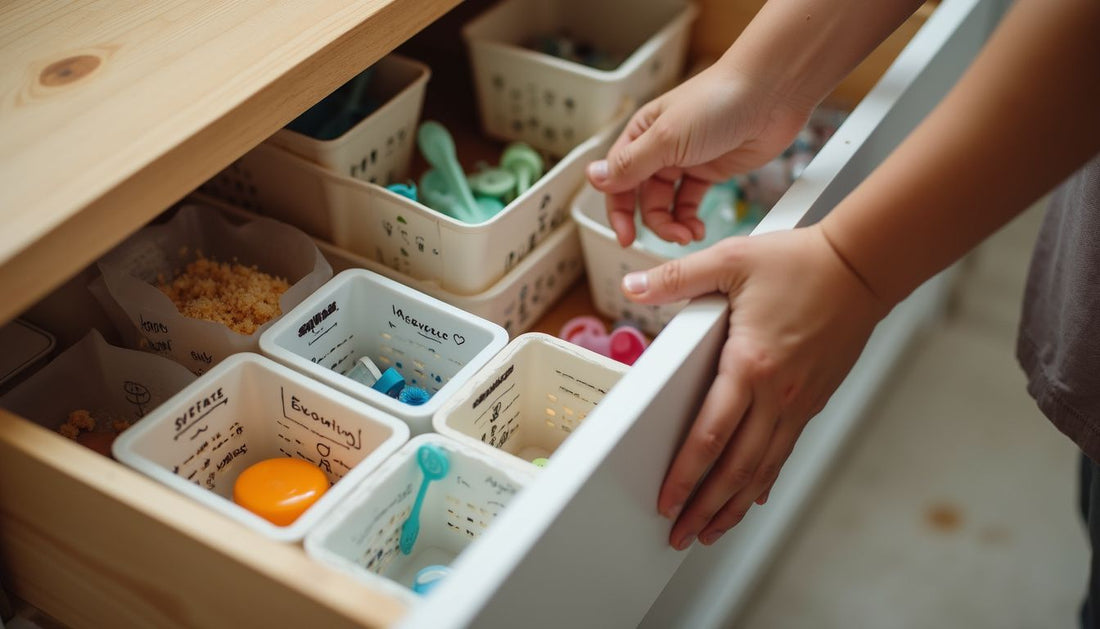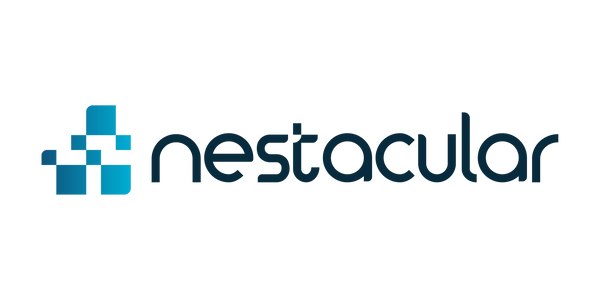
How To Store Baby Utensils Efficiently
Share

Baby spoons in the wrong drawer again? Sippy cups hiding behind the bread bin? Smart organisation cuts mess and stress, and saves precious minutes at mealtime.
This guide shows you how to store baby utensils efficiently. You will get simple storage solutions, easy labels, and space savers that actually work.
Key Takeaways
- Use labelled drawers or bins near your feeding area to cut search time.
- According to the NHS, clean feeding items after each use and sterilise before reuse to reduce contamination risks. NHS guidance: https://www.nhs.uk/conditions/pregnancy-and-baby/sterilising-bottles/
- Clear BPA-free containers with lids protect sterilised utensils from dust and pests.
- Declutter every two months. Discard cracked bowls, faded spoons, and stretched bottle nipples at once.
- Over-the-door organisers create vertical storage without tools or bulky furniture.
Designated Storage Areas for Baby Utensils

Set one drawer or cupboard just for baby feeding supplies. Add bright labels so even sleepy eyes find the right cup at sunrise.
How do I choose separate drawers or sections for baby utensils?
 Pick a drawer close to where you feed your child. Short trips mean faster prep and fewer spills. Use drawer dividers or small bins to group spoons, forks, bowls, and teats in their own spots.
Pick a drawer close to where you feed your child. Short trips mean faster prep and fewer spills. Use drawer dividers or small bins to group spoons, forks, bowls, and teats in their own spots.
Silicone spoons in one section, soft-tipped forks in another. If space is tight, choose a clear lidded box for utensils and place it on a low shelf.
Grouping by type stops older kids mixing their plates with baby items. Keep tools near the high chair to speed up clean-up. No frantic dashes between rooms.
A tidy kitchen makes mealtimes less of a circus act with babies,says Christina Bell, mum of two from St Louis, Missouri.
How can labels help with quick identification of utensils?

Labels end the morning scramble. A simple sticker, like newborn to 3 months
, points you straight to the right spoon in seconds.
Label by age stage or use. For example, 6 plus months
or sterilised only
. Clear tags help partners, grandparents, and older siblings put things back correctly.
Write dates on containers holding sterilised items. You can spot clean gear at a glance.
Optimising Space Utilisation for Baby Utensil Storage

Baby feeding supplies spread fast. Clever storage solutions give you space back and keep the kitchen calm.
What are the best clear bins and compartment dividers to use?

Choose clear bins with sturdy lids. They keep spoons, forks, and weaning tools safe from dust and curious hands. Pick BPA-free plastic or glass for peace of mind.
Airtight lids limit moisture, so items stay fresh instead of musty. A matching set from the same brand looks tidy on shelves and lets you see what you have without digging.
Compartment dividers turn a jumbled drawer into neat rows. Use trays with several slots to separate sippy cup parts from dummies. Clear acrylic shows what is clean, and nothing gets lost at the back.
Seeing everything at once saves time and keeps tempers down.
Next up, make dead space work for you with vertical storage.
How can over-the-door organisers create extra storage space?

Even a well organised drawer fills quickly. Over-the-door organisers add storage without drills or heavy furniture. Hang one on a pantry or utility door for bibs, teethers, snack pots, and sippy lids.
Use top pockets for back-up items. Keep daily gear in the middle so you can reach it instantly. Stacking vertically frees worktops and drawers for the essentials.
They suit narrow doors and most decor styles.
How do I keep baby utensils clean and hygienic?

Clean utensils help keep feeding routines smoother and safer for families. Good storage makes it easier to stay on top of it.
How often should I sanitise baby utensils?

Babies explore with their mouths, so clean feeding gear matters. According to the NHS, wash bottles, teats, and weaning items in hot soapy water after each use, then sterilise before reuse. NHS guidance: https://www.nhs.uk/conditions/pregnancy-and-baby/sterilising-bottles/
Use a steam steriliser for speed at home. Place items in once washed to target bacteria that normal dishwashing may miss. Follow the device instructions and store items properly after.
Why use covered containers for sterilised utensils?
Dust and germs drift around any home. Store sterilised utensils in BPA-free containers with tight lids to shield them. Keep bottles and nipples upright so water can dry off and the lids can stay sealed.
Covered containers also mark what is clean. A simple label finishes the system. Clear bins let you check status at a glance, then grab and go.
How can I rotate and declutter baby utensils regularly?
Babies outgrow spoons and cups quickly. Sort gear every one to two months. Play a short playlist and clear the drawer while it runs.
When should I discard baby utensils I no longer need?

Bin cracked bowls, chewed nipples, and faded spoons right away. Worn surfaces can trap dirt in tiny scratches. Every few months, empty your box and check rubber parts for splits or stretch marks.
I once found a lid nearly bitten through during teething. Out it went. If a nipple feels sticky or misshapen after months of use, replace it.
Keep only what fits inside your chosen drawer or bin. If something gathers dust, you will not miss it. Plastic bags tear and trap damp, so use sturdy BrandABC bins instead.
How do I arrange essential utensils for easy access?
Group by type and size. Keep spoons, forks, and silicone feeders together. Place everyday tools at the front of the drawer or bin for quick grabs.
Sort by age stage. Put newborn bottles ahead of toddler snack pots if those are used more often. Less-used items go higher up or at the back.
Store plates and cups low so older children can reach. That tiny bit of independence saves you time too. Labels help guests find what they need without a guided tour.
Conclusion

Storing baby utensils efficiently frees up kitchen space and headspace. Labels and divided drawers speed up breakfast and calm the usual rush.
Use covered bins to protect clean supplies from dust or little hands. Keep small baskets for sippy cups and pacifiers in easy reach. Keep sturdy items, but toss anything worn or cracked for safety.
A quick tidy each week stops clutter creeping back. With simple organisation, the next time you need that favourite spoon, you will know exactly where it lives.
